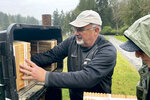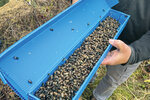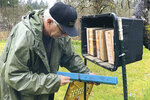


For Jim Watts, spring means time on the road with hundreds of thousands of bees in his truck. One by one he visits an ever-growing list of home orchards, hobby farms, clearcuts and gardens. At each, in a modified tote suspended on posts, he deposits a wood block filled with holes and a box of dormant mason bees.
From his base in Bothell, Watts spreads bees from British Columbia to Eugene and into the Sierra foothills in California. The Key Peninsula has become a special terrain for him. His bees love it too.
“The peninsula has a lot of diversity of flowering trees and shrubs, which is ideal for bees,” he said, citing fruit trees, big-leaf maple, madrona — even Scotch broom. "And people are super nice out here.”
Watts’ company, Watts Solitary Bees, sells leafcutter and mason bees to commercial farms for pollination of crops. The totes scattered on private properties are his way of breeding the bees. There is no charge to the property owner, who gets the benefit of better pollination in their home garden. Watts returns in early summer to collect the blocks, by then full of mason bee pupae. His goal is to double his bees every year.
The species he uses, Osmia lignaria, known as the blue orchard bee, is native across the United States. Unlike honeybees, mason bees are solitary. The females roll the pollen and nectar they collect into balls which they hide in tubes, such as dead reeds. Each ball of pollen gets a single egg before it is walled off with mud. Visiting tens of thousands of flowers in its two-month lifespan, a female makes a series of these cells, up to a dozen in a single tube.
The adult males live hardly two weeks. Their only job is to fertilize the females. The female decides if each egg will be female or male. It lays females deepest in the tubes.
By the first of June, the adults are dead. The eggs have hatched into larvae that have eaten the pollen and entered a ten-month pupation to wait for the next spring. In Bothell, Watts keeps millions of the pupae on a precise temperature regimen.
“We get above a 95% hatch rate every spring, so pretty healthy bees,” he said with the pride of a dog breeder.
Mason bees are active at 50 degrees, 10 degrees colder than honeybees, offering a big advantage for spring-flowering crops. Watts is a pioneer in this work, which began only 15 years ago. “It has so far to go, we’re hardly started,” he said.
His father Roger Watts, a schoolteacher in rural eastern Oregon, started the business in 1965 as a project to see if leafcutter bees, another native solitary species, could be used to pollinate summer seed crops like alfalfa. It worked, and a hundred million leafcutter bees remain the heart of Watts Solitary Bees.
Jim Watts wanted nothing to do with bees by the time he went to college — he was a math major — and he started a construction business after. But in the end it was too good a business to resist. The money for pollinators is excellent, he felt it was important work, and his dad, who has “forgotten more things than most people know about solitary bees,” put him far ahead of any competition.
They are up to 2,000 acres pollinated by mason bees, a sliver of the vast acreage of orchards in the West. Honeybees are the standard pollinator. “Nobody else is doing what we’re doing,” he said. “It looks pretty simple, but it’s actually pretty complicated to make it work.”
In commercial orchards, bees don’t reproduce well. Take California almond orchards, totaling over a million acres. An orchard, stretching for miles of bare dirt and almond trees, has nowhere for pollinators to turn when the trees stop blooming. So honeybee hives are trucked around the country throughout the growing season, moving from crop to crop. Viruses spread rapidly.
Watts provides some almond growers with mason bees. Previously, honeybees were stocked at two hives per acre: good for pollination, close to starvation level for the bees. The growers replace one hive with 1,000 mason bees and, with plenty of pollen and nectar to go around, the honeybees emerge from the orchard far healthier than before. “The honeybee guys saw us as competition at first,” Watts said. Now they simply do more acres and, with healthy bees, have a leg up on the rest of summer.
The bee business is unique in that it requires rural landscapes full of diverse blooms to build bee populations at a scale that can pollinate modern agriculture.
Watts’ doorway to the KP was at a native plant sale, where he got to talking to a man who said he had 10 acres in a place called Longbranch. The man would love to have some bees. Watts looked it up on Google Maps. It looked like the right kind of vegetation.
“We put out five or six totes; quite a few bees for just trying something,” he said. “Came back three weeks later and they were all full. I was like, ‘Sweet!’ ”
Neighbors told neighbors. Each year has given him access to more properties. He has spoken at the Longbranch Improvement Club and the KP Civic Center. This year he put something like 800,000 bees in 500 totes across the region, including the Tahuya Peninsula and Harstine Island. “It’s a lot of bees, but it’s not very many, to be honest,” he said.
Now he has seven years of data, organized tote by tote. Last year was the worst he’s had with rain clear into June. The year before was the best. This year he is adding a bundle of cardboard tubes to select totes. At the end of the summer, a researcher at UC Davis will analyze the pollen left in each nest cell to learn the exact plants the mason bees are using at each site. It is one of a handful of research projects Watts is involved in.
One open question is how much mason bees visit huckleberry. If mason bees like huckleberry flowers as much as maple flowers, it will open a vast terrain for beekeeping. Two years ago, Manke Lumber Company gave Watts a master key to their logging roads and invited him to place bees wherever he wanted. “We’re finding that clearcuts are very good for bees,” Watts said. “After about two years, stuff starts growing and blooming and there is a ton of bloom in those clearcuts. We figure we have about a 10 year period, maybe 15 — we’ll see — before the trees take over.”
For Watts, whose route of sites is based on grassroots relationships and word of mouth, much of the joy in his job comes from the chance to talk with people and hear their stories.
“It’s interesting out here, all economic strata, a lot of retired people who have done all kind of crazy things in their lives,” he said.
Then there are the farmers. “I would say that most farmers take seriously the idea of feeding the world. A lot of times people think everything is corporate farms and nobody cares, but I just don’t find it to be that way. I think that people actually do care. They’re trying to do the right things.”
For more information, go to http://www.wattsbees.com
UNDERWRITTEN BY THE FUND FOR NONPROFIT NEWS (NEWSMATCH) AT THE MIAMI FOUNDATION, THE ANGEL GUILD, ADVERTISERS, DONORS AND PEOPLE WHO SUPPORT INDEPENDENT, NONPROFIT LOCAL NEWS